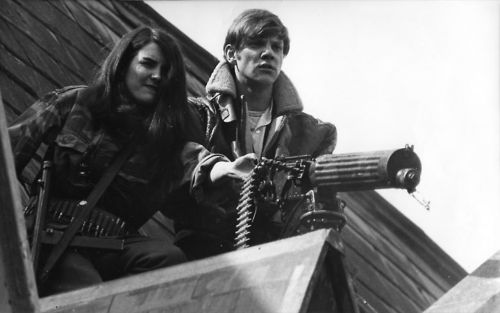Do Unto Others, the External Examiner
I was recommended for the Graphic Design panel on the Council for National Academic Awards (CNAA). Attending my first meeting, I was ambushed on the stairs by the Chair who advised me to ‘keep schtum’ and find my feet in my first session. The proceedings were lacking in coherence, and full of in-jokes. I remember asking for a clarification of one aside and being ignored. I was unaware, as indeed the Chair was too, that this was the last of the Panel’s meetings ever. So keeping schtum was hardly the best policy. Every now and then I would be sent as a CNAA representative to a course in trouble or one with worrying complacency and attend validations and revalidations. At briefing meetings, the external chairman (always a man) would reveal a hidden agenda not contained in our papers – to close down the Illustration Course at Chelsea – to give Falmouth a whacking – get Nottingham modularised. At one stage I believed participation would enhance my career, only to find it depressed my spirits. Fellow members of the panel postured and bluffed. Little consideration there was of the students. Those students we were invited to meet looked nervous or perhaps drugged into compliance. AS EXTERNAL EXAMINER It was an expected part of the assessment of student work that peers from other art schools rolled in to check procedures and ensure consistency of standards across the realm. There was a division of opinion. Are you a Helper or a Policeman? Are you referee or guru? EXAMPLE 1 (Referee) : In 1994, as an external examiner myself I arrived at a major assessment meeting to be asked to settle a dispute caused by three different ranges of marks relating to pass and fail distributed to staff and students. They seemed easily satisfied with my decision which was a toss up with a three sided coin. EXAMPLE 2 : (Policeman) My old pal David Dawson suggested me as an external examiner in an Art Academy in the East franchised by a large University in London believing that I would not be fobbed off with the Top Dog’s schtick. I turned down the offer of a flat in town and ‘hospitality’ in advance of the Assessment. The Top Dog’s office was unusually spacious, decorated by over a dozen portraits of wife and children. I found however that there was no paperwork attached to my appointment, beyond a polite billet doux rendering my endorsement of the marks meaningless. It would have been difficult anyway to endorse fifteen firsts among the sixteen students. I even got a reference to the conventional ‘rubber chicken’ catering into my Report. EXAMPLE 3: (Lawyer) I examined an Information Design course in its London incarnation in a display mounted over a restaurant. My fellow examiner Colin Banks refused to endorse the degrees, as the work we were asked to ratify bore no resemblance to the course documents. A man of undoubted probity and a pioneer of typography both functional and expressive, Colin stuck it out when the Examination Board was held several days later at the University site, What larks! Colin and I fought our way through jeering and chanting pickets. We reluctantly endorsed the degrees after undertakings that the work the following year would address information, and permit fewer expressive clouds of meaningless pastel overdrawn with Ben Shahn type. EXAMPLE 4: At another validation meeting of another art school along the South Coast, our initial refusal to endorse the course meant that all subsequent hospitality ceased and we had to make our own way back to the Railway Station, watching our backs all the way like something out of a John Ford movie. David Hillman and I were criticised for not attending the subsequent validation. But then, they overlooked sending invitations. What a stitchup! EXAMPLE 5: Puncturing the Zeppelin. George Hardie and I were External Examiners at one Academic Multiplex in the South of England . The forlorn and inadequate junior lecturers and technicians we had encountered in the past were now freshly minted for the entrepreneurial future. I had never seen such smart costuming and grooming, such bravura of presentation, and such flabby language deployed to describe the blindingly obvious. At one Final Assessment Board I delivered a prepared statement as to the inadvisability of inventing an annual academic procession in full mufti through the town to celebrate the awarding of degrees. It was none of my business but the spirit of Lindsay Anderson’s film If haunted my imagination. Whether they heeded me I know not. But I gave it the full Donald Wolfit.
EXAMPLE 6: the Courses’ Little Helper. I found it impossible to overtly criticise the conduct of courses in the full arena of the Exam Board. Much more could be achieved in debate with the staff. Several of my peers at Boards indulged in hissy fits and sudden extemporised ramblings on the nature of art. Many’s the time I would be searching through my papers seeking the identity of some Dolt in a corduroy waistcoat whose eyes swivelled in different directions as he knocked over his coffee cup. Professor Jam Jar from Kirkup? Where did they get him from? Three courses I examined appeared to be under siege from their Fine Art equivalents, as to accommodation, resources and the final show. It was explicitly argued that Fine Artists needed walls, spotlights and hi-fidelity sound, where Designers and Illustrators could all fit in a vitrine. Wielding my Doctorate like a Club, I adduced evidence to the contrary, sitting back while the Chairman then shimmied his way towards the middle ground. But I was a firm believer in giving as good as you got, to save time on the next occasion your paths crossed. I confess to enjoying the Thespian aspects of these dust-ups at Art Schools.
|

